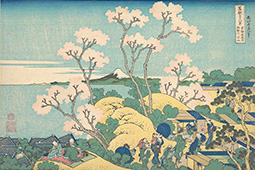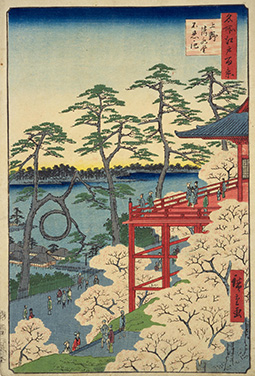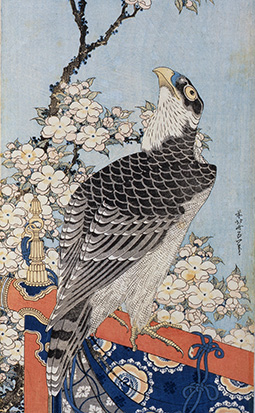
Fuji from Gotenyama on the Tokaido at Shinagawa by Katsushika Hokusai 
Kiyomizu Hall and Shinobazu Pond at Ueno by Utagawa Hiroshige 
Hawk and Cherry Blossoms by Katsushika Hokusai
April 2021
Cherry Blossoms in Ukiyo-e

Looking at the cherry blossoms depicted in ukiyo-e Japanese woodblock prints, it is clear to see that the spring flowers charmed the people of Edo, present-day Tokyo.

Ukiyo-e is an art which flourished in the Edo period (early seventeenth to mid-nineteenth centuries), when many artists produced colorful prints from hand-carved wooden blocks. The subject matter of ukiyo-e was wide-ranging, including famous tourist spots, scenes from nature, popular actors, sumo wrestlers and even soba noodles and tempura.
The Ota Memorial Museum of Art is Japan’s pre-eminent ukiyo-e museum. Curator Hinohara Kenji says, “One of the subjects of ukiyo-e is cherry blossom landscapes. A characteristic of ukiyo-e is their depiction of places bustling with people enjoying themselves, and there are many such ukiyo-e of famous cherry blossom locations.” According to Hinohara, “Ukiyo-e prints from the time show that Japanese people without regard to their social class have been admiring cherry blossoms since the Edo period.
Prime examples of such prints are Kiyomizu Hall and Shinobazu Pond at Ueno and Suijin Shrine and Massaki on the Sumida River, from the One Hundred Famous Views of Edo series by Utagawa Hiroshige (1797–1858); and Fuji from Gotenyama on the Tokaido at Shinagawa, from the Thirty-six Views of Mt. Fuji series by Katsushika Hokusai (1760–1849). Hinohara says, “A feature of these prints, which depict famous places, is that they describe the entire landscape including cherry blossoms. Some of these places are still popular cherry blossom viewing spots today and others are not. It is interesting to look at the landscapes of Edo depicted in ukiyo-e and compare them to the contemporary landscapes.”

Cherry trees were also used by artists to make the woodblocks. Hinohara says, “Yamazakura (Japanese mountain cherry) wood is neither too hard nor too soft and is well suited for carving.”
In 2020, the original woodblocks for Katsushika Hokusai’s Hawk and Cherry Blossoms were discovered. Unlike the landscape prints featuring famous places, this print zooms in on a hawk and cherry blossoms.
Hinohara says, “Flowers and birds have been auspicious motifs for Japanese paintings throughout the ages. The popularity of ukiyo-e prints featuring these motifs is a good indication of the Japanese people’s love of nature.”
It is said that the cherry blossoms express the transience of nature while the hawk symbolizes valiance and clear-sightedness with its ability to see far into the distance and soar high into the sky. Hokusai’s Hawk and Cherry Blossoms is widely considered a gem of the ukiyo-e genre for its combination of these two elements.


